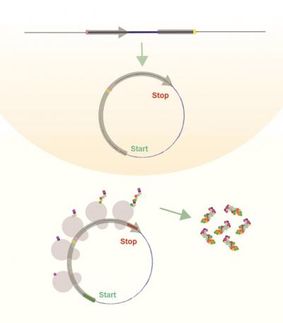Mediator in communication between neurons and muscle cells found
Advertisement
A missing piece of the puzzle of how neurons and muscle cells establish lifelong communication has been found by researchers who suspect this piece may be mutated and/or attacked in muscular dystrophy. Agrin is a protein that motor neurons release to direct construction of the nerve-muscle contact or synapse. MuSK on the muscle cell surface initiates critical internal cell talk so synapses can form and receptors that enable specific commands will cluster at just the right spot.
The conundrum was agrin and MuSK don't directly communicate, explains Dr. Lin Mei, chief of developmental neurobiology at the Medical College of Georgia and Georgia Research Alliance Eminent Scholar in Neuroscience.
Much as a friend gets two other friends together, MCG researchers have found that agrin starts talking with LRP4, a protein also on the muscle cell surface, then recruits MuSK to join the conversation. LRP4 and MuSK become major components of the receptor needed for the muscle cell to receive the message agrin is sending, says Dr. Bin Zhang, postdoctoral fellow in Dr. Mei's lab and first author on the paper published in Neuron.
"We know agrin is important and we know MuSK is important. The puzzle or greatest gap in this field for a long time is there was no evidence these two would shake hands but they must have each other," says Dr. Mei, corresponding author. "This paper shows that this protein, LRP4, forms a nice bridge between the two and solves this long puzzle."
The agrin-MuSK signaling pathway has been implicated in muscular dystrophy. Some reports have implicated a mutant MuSK as a cause of muscular dystrophy and autoantibodies (antibodies the body makes against itself) to MuSK have been found in the blood of some patients.
Now that researchers know LRP4's critical role, they will look in patient samples where they suspect they also will find mutant forms and autoantibodies to it as well, Dr. Zhang says. They'll also look to see if LRP4 has a role in later development and maintenance of the neuromuscular junction.
In research published in Neuron, the same research team used the neuromuscular junction to identify Hsp90β as a stabilizing protein that helps receptors on muscle cells get and stay where needed to catch a neuron's signal. This process showed the need for teamwork as well since rapsyn, a protein responsible for anchoring the receptor, is oddly unstable. They showed Hsp90β gives rapsyn needed stability.
Other news from the department science
Most read news
More news from our other portals
See the theme worlds for related content
Topic world Antibodies
Antibodies are specialized molecules of our immune system that can specifically recognize and neutralize pathogens or foreign substances. Antibody research in biotech and pharma has recognized this natural defense potential and is working intensively to make it therapeutically useful. From monoclonal antibodies used against cancer or autoimmune diseases to antibody-drug conjugates that specifically transport drugs to disease cells - the possibilities are enormous

Topic world Antibodies
Antibodies are specialized molecules of our immune system that can specifically recognize and neutralize pathogens or foreign substances. Antibody research in biotech and pharma has recognized this natural defense potential and is working intensively to make it therapeutically useful. From monoclonal antibodies used against cancer or autoimmune diseases to antibody-drug conjugates that specifically transport drugs to disease cells - the possibilities are enormous






















































